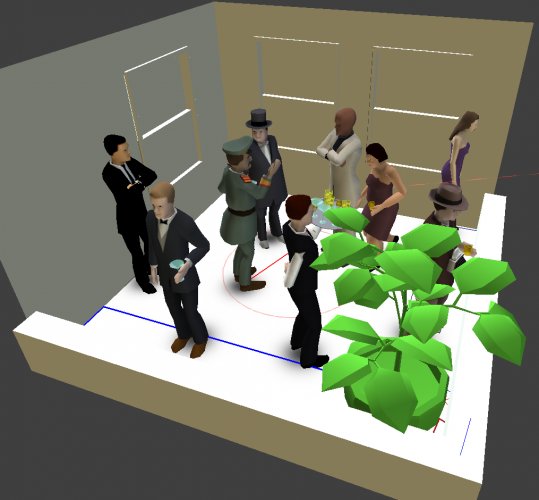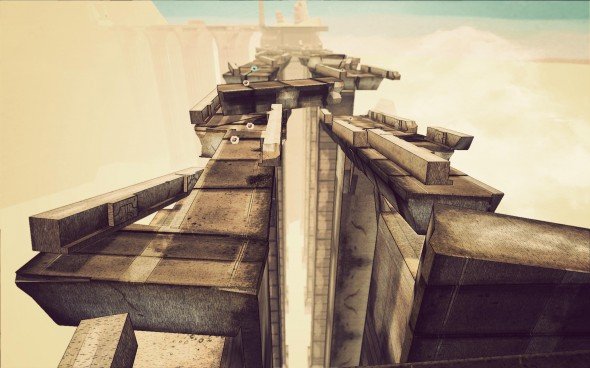The future of indie
Spy Party

Most multiplayer games are about shooting the other person as soon as they appear, but in Spy Party you have to find the human in a sea of NPCs. It's about understanding human behaviour, not guns.
There are two roles: the Sniper and the Spy. The Sniper watches as the Spy schmoozes his way around a party, attempting to conceal his activities in the group of revellers. It's classic spy stuff, like retrieving a microfilm, swapping a statue or seducing a target, all performed as the laser beam from the sniper's rifle is sweeping over the room, looking for the telltale animation.
As the Spy, the difficulty is in timing the moments of covert action to occur when the Sniper is distracted, and acting like an NPC at the other moments, trying to place your character very carefully in the correct position to make it look like you're not trying to place your character. Moving like a human is a dead giveaway.
All the while the Sniper watches. As the gunman, you get a single bullet to take out the espionage agent, and it's an overwhelming amount of information to parse. The NPCs mimic a lot of the Spy's moves, but without the subtle tells. Staring at all the activity, your eyes flick from person to person, trying to catch one of them out. The concentration required to keep all the accusatory and dismissive thoughts in your head, with a whole room of people acting independently, makes it difficult to take that shot. Which a good Spy will take advantage of. The asymmetry creates a terrifying atmosphere for both players, particularly when the Sniper clocks the Spy early on and lets him carry on.
Developer Chris Hecker's currently working on level layouts: a smaller, balcony level skews the game towards the Sniper's abilities, whereas an L-shaped room full of people gives the Spy a better opportunity to succeed. He's using those unbalanced spaces to explore how to balance the game: Spy Party's mechanics might be easy to pick up and learn, but that's just the start of a complex game where you have to think about the humanity in what you're doing.
Subversion
Keep up to date with the most important stories and the best deals, as picked by the PC Gamer team.

Robbery is the new lens flare. Introversion's Subversion puts you in charge of a team of skilled break-in experts, taking apart hightech security systems to get to the loot.
Being from the developers of Uplink, the depth of the simulation is what makes this a fascinating prospect: guns are a fall back position for when things go wrong. Instead you'll be taking down security systems, moving your agents in concert as layer after layer of protective technology is tapped into. The modern office setting gives some familiarity to the world: security cameras are hackable to give the team a better PoV of the layout, telephone wires can be analysed, with 999 calls rerouted to hold off police intervention while the building is hacked.
The team's skills aren't limited to tweaking tech, either: agents can talk their way out of situations, using Fast-Talking augmentations, or simply sneak in, following someone with access to get through a locked door. Of course, you might need to leave via that door, which is where a gun or two could come in handy. Social engineering is all well and good, but a bullet really focuses people.
There's a clear air of the unknown about Subversion, not unintentionally, since Introversion are still refining the concept as they're developing it. But the heist theme, the emergent possibilities and the unusually high quality of their previous games is enough to sustain our interest.
Tiny & Big

It's almost a shame to be let loose in Tiny & Big's world. It's gorgeous: a hand-drawn, sketchy backdrop full of immense character and charm. And what do you do here? Tear it all up on a quest for your inheritance: a pair of fine white underpants.
It's an environmental third-person puzzle game: everything from the tallest spires to the smallest rocks can be sliced apart by Tiny's laser. It burns through the landscape like a sausage through margarine, turning massive pillars into makeshift bridges, wrecking the carefully contoured world but enabling Tiny to cross otherwise impossible chasms on his hunt for the pants. The scale is as impressive as the technology: the cuts aren't prescribed, so you can chop a giant Redwood-sized tooth of granite neatly across the trunk, felling it like a tree, or slice it up into slivers, chipping away at it, hoping the pieces fall correctly. Or just for fun.
But it's not all left to chance: Tiny also has a grappling hook that you can drag the rubble around with, using it to angle his toppling towers. Or you can manoeuvre the collapsed levels into the desired shapes, like stairs, to chase his pant-stealing nemesis. There's also a rocket to push pieces around if you need to apply a bit more force than the grappling hook provides, or merely turn them into jagged, terrifying, self-propelled shards of angry landscape.
Mechanically, it all seems so obvious. It has the feeling of a game that should have been made a long time ago, and it took a small, student development team to realise it. Developers Black Pants (they seem obsessed with underwear this lot) are episodically releasing the game in level-sized chunks, but they've already released a demo on their site for free. Even in its raw state, it's still immensely enjoyable.
Snapshot

Photography isn't just a way to show everyone how miserable your family holidays were, or how fluffy your new kitten is (and he is so, so fluffy ), oh no. In Snapshot, camera clickery can change the world around you.
It's a pretty, elegant, Braid-like puzzle platformer. You guide your little robot through platform puzzles. They're impossible to traverse normally, until you make use of your camera. It absorbs the world's objects into the photographs it takes and allows you to place them elsewhere in the level. Thankfully it's digital, so there's no time wasted waiting for them to develop.
At the most basic level, you'll use it almost like a gravity gun, plucking a crate from one part of the level and depositing it elsewhere, in turn placing the photograph where you need the object to be to boost your robot up, or lean on a useful switch. More complicated uses come into play, though: the photos capture object momentum, light, and even chunks of architecture. Blimey.
So, say you need to destroy the floor of a platform that's out of reach. You can photograph a falling rock, place the photograph upside down underneath the breakable barrier and the rock will fly out at the desired angle. You can use the same effect to kill an enemy, so you could push a crate off a ledge, capture it mid fall, drop the photo over the enemy and smoosh them. The power of photography!
Lightsources plucked from the backdrop can be used to help guide the bot through pitch-black levels, with the tiny suns rolling around when freed from their positions.
Even the platforms are manipulable: you can photograph a spiked landing, turning it upside down so the spikes are on the bottom and you're safe to land on it – or there are level doors that you can access by ripping them from an awkward position to an easyto- reach spot.

